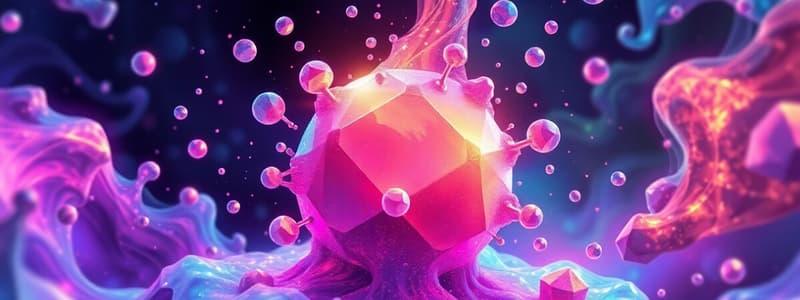Podcast
Questions and Answers
Which of the following best describes the relationship between compounds and elements?
Which of the following best describes the relationship between compounds and elements?
- Compounds are substances that cannot be broken down into simpler substances, which are elements.
- Compounds are composed of two or more elements chemically combined in a fixed ratio. (correct)
- Elements are composed of two or more compounds chemically combined.
- Elements and compounds are both mixtures of different substances.
When iron rusts, it combines with oxygen in the air to form iron oxide. This process is an example of what kind of change?
When iron rusts, it combines with oxygen in the air to form iron oxide. This process is an example of what kind of change?
- A physical change, because the iron can be returned to its original state.
- A chemical change, because a new substance with a different composition is formed. (correct)
- A chemical change, because the total mass of the iron remains the same.
- A physical change, because the iron's appearance changes.
Consider two isotopes of the same element. Which statement is always true?
Consider two isotopes of the same element. Which statement is always true?
- They have the same mass number but different atomic numbers.
- They have the same number of electrons but different numbers of protons.
- They have the same number of protons but different numbers of neutrons. (correct)
- They have the same number of neutrons but different numbers of protons.
Which type of chemical bond involves the sharing of electrons between atoms?
Which type of chemical bond involves the sharing of electrons between atoms?
In a chemical reaction, 10 grams of reactant A and 15 grams of reactant B are mixed. After the reaction, it is found that reactant A is completely consumed, while some of reactant B remains. Which is the limiting reactant?
In a chemical reaction, 10 grams of reactant A and 15 grams of reactant B are mixed. After the reaction, it is found that reactant A is completely consumed, while some of reactant B remains. Which is the limiting reactant?
A solution is prepared by dissolving 2 moles of NaCl in enough water to make 5 liters of solution. What is the molarity of the solution?
A solution is prepared by dissolving 2 moles of NaCl in enough water to make 5 liters of solution. What is the molarity of the solution?
In the following reaction: $HCl + NaOH
ightarrow NaCl + H_2O$, which species acts as the acid?
In the following reaction: $HCl + NaOH ightarrow NaCl + H_2O$, which species acts as the acid?
During an oxidation-reduction (redox) reaction, a substance loses electrons. What is this process called?
During an oxidation-reduction (redox) reaction, a substance loses electrons. What is this process called?
Which of the following correctly describes an exothermic reaction?
Which of the following correctly describes an exothermic reaction?
A radioactive isotope has a half-life of 10 years. If you start with a 100-gram sample, how much of the isotope will remain after 30 years?
A radioactive isotope has a half-life of 10 years. If you start with a 100-gram sample, how much of the isotope will remain after 30 years?
Flashcards
What is Chemistry?
What is Chemistry?
The study of matter and its properties and how matter changes.
What is Matter?
What is Matter?
Anything that has mass and takes up space.
What is an Element?
What is an Element?
A substance that cannot be broken down into simpler substances by chemical means.
What is a Compound?
What is a Compound?
Signup and view all the flashcards
What is a Mixture?
What is a Mixture?
Signup and view all the flashcards
What are physical properties?
What are physical properties?
Signup and view all the flashcards
What are chemical properties?
What are chemical properties?
Signup and view all the flashcards
What are Protons?
What are Protons?
Signup and view all the flashcards
What are Isotopes?
What are Isotopes?
Signup and view all the flashcards
What is Half-life?
What is Half-life?
Signup and view all the flashcards
Study Notes
- Chemistry is the study of matter, its properties, and how matter changes
- Matter is anything that has mass and occupies space
- Pure substances have constant composition and fixed properties
- Elements are substances that cannot be broken down by chemical means
- Compounds are substances with two or more elements chemically combined in a fixed ratio
- Mixtures combine two or more substances physically
- Homogeneous mixtures have uniform composition and properties throughout; these are also known as solutions
- Heterogeneous mixtures have non-uniform composition and properties
- Physical properties are observable/measurable without changing the substance's composition, like color, density, and melting point
- Chemical properties describe changes in composition through reactions, like flammability and reactivity with acid
- Physical changes do not alter a substance's composition, examples include melting and boiling
- Chemical changes involve altering the composition of a substance, such as burning or rusting
- Atoms are the smallest units of an element retaining its chemical properties
- Protons are positive particles in an atom's nucleus
- Neutrons are neutral particles in an atom's nucleus
- Electrons are negative particles orbiting the nucleus
- Atomic number (Z) is the number of protons in an atom's nucleus, defining the element
- Mass number (A) is the total number of protons and neutrons in an atom's nucleus
- Isotopes are atoms of the same element but with different numbers of neutrons
- Ions are atoms or molecules with a net electric charge due to gained or lost electrons
- Cations are positive ions formed by losing electrons
- Anions are negative ions formed by gaining electrons
- Molecules consist of two or more atoms held together by chemical bonds
- Chemical bonds are attractive forces holding atoms together in molecules or compounds
- Ionic bonds form through electrostatic attraction between oppositely charged ions
- Covalent bonds form through the sharing of electrons between atoms
- Metallic bonds form through electron sharing within a metal lattice
- Chemical reactions rearrange atoms and molecules
- Reactants are substances that undergo change in a chemical reaction
- Products are substances formed as a result of a chemical reaction
- Balanced chemical equations represent reaction stoichiometry, ensuring equal atom count of each element on both sides
- The mole (mol) is the SI unit for the amount of substance, equivalent to the number of entities in 12 grams of carbon-12
- Avogadro's number (NA) is about 6.022 x 10^23 entities in one mole
- Molar mass is the mass of one mole of a substance, expressed in grams per mole (g/mol)
- Stoichiometry is the quantitative relationship between reactants and products in a reaction
- A limiting reactant is fully consumed, determining maximum product formation
- Percent yield is the ratio of actual yield to theoretical yield, expressed as a percentage
- Solutions are homogeneous mixtures of multiple substances
- A solute is the substance being dissolved
- A solvent dissolves the solute
- Concentration is the amount of solute in a solvent or solution
- Molarity (M) is moles of solute per liter of solution (mol/L)
- Acids donate protons (H+) in aqueous solutions
- Bases accept protons (H+) in aqueous solutions
- pH measures acidity/basicity, defined as -log[H+]
- Acid-base reactions transfer protons from acids to bases
- Neutralization is the reaction between an acid and a base, producing salt and water
- Oxidation-reduction (redox) reactions transfer electrons
- Oxidation is the loss of electrons
- Reduction is the gain of electrons
- An oxidizing agent causes oxidation by accepting electrons
- A reducing agent causes reduction by donating electrons
- Thermodynamics studies energy changes in chemical and physical processes
- Energy enables work or heat transfer
- The first law of thermodynamics states energy is conserved
- Enthalpy (H) measures heat content at constant pressure
- Exothermic reactions release heat (ΔH < 0)
- Endothermic reactions absorb heat (ΔH > 0)
- Entropy (S) measures disorder or randomness
- The second law of thermodynamics states entropy increases in isolated systems over time
- Gibbs free energy (G) combines enthalpy and entropy to determine spontaneity
- Spontaneous processes occur without intervention (ΔG < 0)
- Chemical kinetics studies reaction rates and influencing factors
- Reaction rate is the change in reactant or product concentration per unit time
- Factors affecting reaction rate: temperature, concentration, surface area, catalysts
- A catalyst increases reaction rate without being consumed
- Equilibrium is when forward and reverse reaction rates are equal
- The equilibrium constant (K) is the ratio of product to reactant concentrations at equilibrium
- Le Chatelier's principle states that a system at equilibrium will shift to relieve stress from any applied change
- Organic chemistry studies carbon-containing compounds
- Carbon can form stable bonds with itself and other elements, leading to diverse organic molecules
- Hydrocarbons contain carbon and hydrogen
- Alkanes have only single bonds
- Alkenes have one or more double bonds
- Alkynes have one or more triple bonds
- Functional groups dictate characteristic chemical reactions of molecules
- Polymers are large molecules made of repeating monomers
- Polymerization joins monomers to form a polymer
- Biochemistry studies chemical processes in living organisms
- Carbohydrates, composed of C, H, and O, are primary energy sources
- Lipids, including fats, oils, and waxes, store energy and form cell membranes
- Proteins, polymers of amino acids, act as enzymes, structural components, and antibodies
- Nucleic acids (DNA and RNA) are polymers of nucleotides carrying genetic information
- Analytical chemistry separates, identifies, and quantifies chemical components
- Qualitative analysis determines presence/absence
- Quantitative analysis determines the amounts of specific substances
- Spectroscopy studies the interaction of electromagnetic radiation with matter
- Chromatography separates components based on differential distribution between phases
Nuclear Chemistry
- Nuclear chemistry involves reactions involving the nuclei of atoms
- Radioactivity is the spontaneous emission of particles or energy from unstable nuclei
- Alpha particles are helium nuclei (2 protons and 2 neutrons)
- Beta particles are high-speed electrons
- Gamma rays are high-energy photons
- Nuclear reactions involve changes in the composition of the nucleus
- Nuclear fission is the splitting of a heavy nucleus into lighter nuclei
- Nuclear fusion is the combining of light nuclei to form a heavier nucleus
- Half-life is the time it takes for half of the radioactive nuclei in a sample to decay
Studying That Suits You
Use AI to generate personalized quizzes and flashcards to suit your learning preferences.




